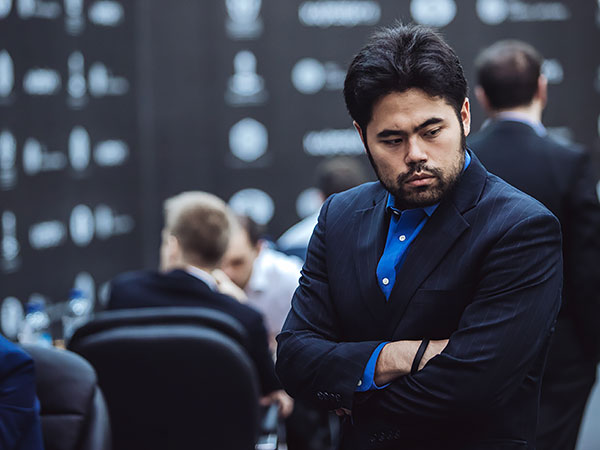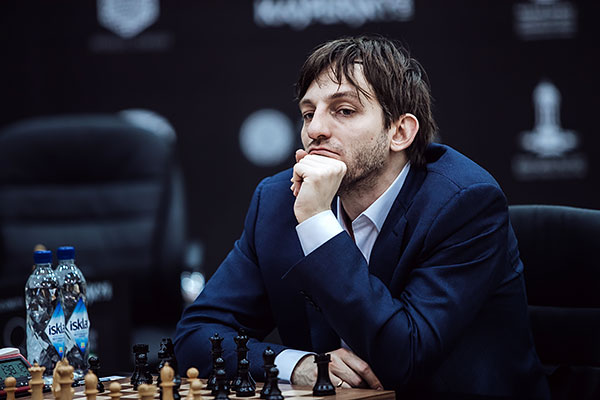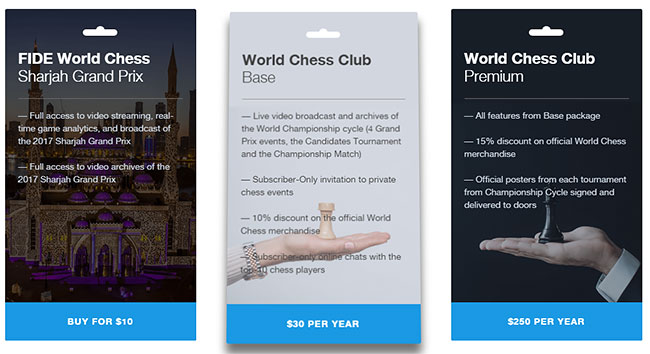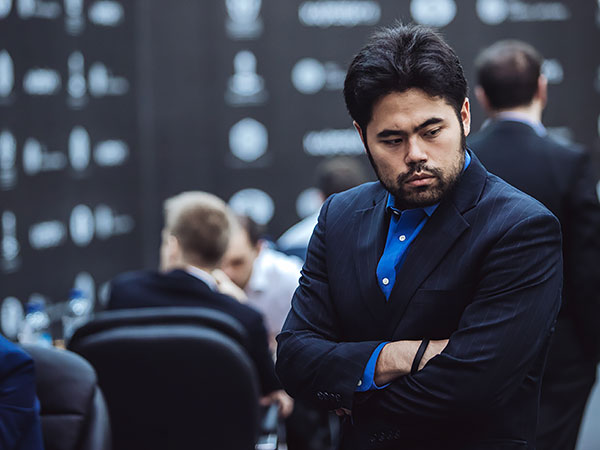The time control in the GP tournaments is 100 minutes for the first 40 moves, 50 minutes for the next 20 moves and then 15 minutes for the rest of the game plus an additional 30 seconds per move starting from move one.
The first leg, in Sharjah, will be held February 18 - 27 (with a rest day on the 23rd) at the Sharjah Cultural & Chess Club. The first prize is €20,000; the total prize fund is is €130,000.
2017 Sharjah GP Participants

All photos by Max Avdeev

A fairly atypical game for the great fighter, Mamedyarov agreed to split the point after a measly 13 moves

Tomashevksy had a nice advantage against Eljanov when they drew, but either saw no way to press for more, or was uncomfortable pushing the issue

Things went very wrong for Li Chao, and the 'drawing' Petroff was instead bamboozeld by a novelty by Ian Nepomniachtchi that included a surprise piece sac three moves later with 15. Bxh6!
Ian Nepomniachtchi vs Li Chao
| Replay and check the LiveBook here |
Please, wait...
1.e4 e5 2.Nf3 Nf6 3.Nxe5 d6 4.Nf3 Nxe4 5.d4 d5 6.Bd3 Bd6 7.0-0 0-0 8.c4 c6 9.Nc3 Nxc3 10.bxc3 dxc4 11.Bxc4 Bf5 12.Bg5 Qc7 13.Re1 h6 14.Nh4 Bh7 15.Bxh6! Bxh2+ 15...gxh6 16.Qg4+ Kh8 17.Nf5 Bxf5 18.Qxf5 Bxh2+ 18...f6 19.Re6 Nd7 20.Rae1 Nb6 21.Bd3 Qd7 22.Qh5 18...Nd7? 19.Bd3 Nf6 20.Qxf6+ 19.Kh1 Qf4 20.Qh3 16.Kh1 Bf4 16...gxh6 17.Qg4+ Kh8 18.Nf5 Bxf5 19.Qxf5 Qf4 20.Qh3 17.Bxg7! Kxg7 18.Qg4+ Kh8 19.Nf5 Bxf5 20.Qxf5 Qd6 21.g3 Bh6 22.Kg2 b5 23.Bb3 Qg6 24.Qxg6 fxg6 25.Re7 g5 26.Re6 Kg7 27.Rh1 Rh8 28.Re7+ Kg6 29.Bc2+ 29.Bc2+ Kf6 30.Rhe1 g4 31.R1e6+ Kg5 32.Rg6+ Kh5 33.Re5+ Bg5 34.Rexg5# 1–0 - Start an analysis engine:
- Try maximizing the board:
- Use the four cursor keys to replay the game. Make moves to analyse yourself.
- Press Ctrl-B to rotate the board.
- Drag the split bars between window panes.
- Download&Clip PGN/GIF/FEN/QR Codes. Share the game.
- Games viewed here will automatically be stored in your cloud clipboard (if you are logged in). Use the cloud clipboard also in ChessBase.
- Create an account to access the games cloud.
| Nepomniachtchi,I | 2749 | Li,C | 2720 | 1–0 | 2017 | C42 | FIDE World Chess Grand Prix 2017 | 6 |
Please, wait...

It wasn't for lack of trying, by Levon Aronian was unable to make...

... Spaniard Francisco "Paco" Vallejo crack.

Richard Rapport bounced back from a difficult phase and defeated Riazantsev to reach parity

In spite of the two outright victories in the sixth round, the game of the day was unquestionably...

... the near win by Hikaru Nakamura over....

... Alexander Grischuk.

Annotating the fascinating game is Tiger Hillarp Persson
Hikaru Nakamura vs Alexandre Grischuk (annotated by Tiger Hillarp-Persson)
| Replay and check the LiveBook here |
Please, wait...
1.Nf3 c5 2.e4 d6 3.d4 cxd4 4.Nxd4 Nf6 5.Nc3 a6 6.Be3 Ng4 6...e6 7.f3 7.Be2 7...b5 8.Qd2 6...e5 7.Nf3 7.Nb3 7.Bg5 7.Bc1 Nf6 7.Bd2 Qb6! 7...h6 8.Bh4 g5 9.Bg3 Bg7 10.h3 10.Qd2 Nc6 11.Nb3 b5 12.h4 b4 13.Nd5 Bxb2 14.Rb1 gxh4 15.Bxh4 Bg7 16.Rc1 Nge5?! 16...Be6 17.f3?! 17.c3! 17...Be6 10.Be2 h5 10...Ne5 11.Nf5 Bxf5 12.exf5 Nbc6 13.Nd5 11.Bxg4 hxg4 12.0-0!? Nc6 13.Nf5 Bxc3 14.bxc3 Qa5 15.Qxg4 f6 16.f4 Bxf5 17.exf5 gxf4 18.Qxf4 Qxc3 19.Rae1 Kd7 19...Kf7 20.Qe4 Rag8?! 20...Qd4+ 21.Re3 Qd4 22.Qe6+ 10...Ne5 10...Nf6 11.Qf3 Qb6 12.0-0-0 Nc6 13.Nxc6 Qxc6 14.Be2 Nd7 15.Nd5 Ne5 16.Qa3 Rb8 17.h4 g4 18.f4 11.Nf5 11.Be2 Nbc6 12.Nb3 b5 13.a4 b4 14.Nd5 e6 15.Ne3 Bb7 16.Qd2 Qc7 17.0-0-0 0-0-0 18.Kb1 Kb8 19.f3 11...Bxf5 12.exf5 Nbc6 12...Qa5 13.Qd5! 12...Nbd7 13.Be2 Rc8 14.0-0 Nb6 15.Rb1 0-0 16.f4 Nec4 17.fxg5 Ne3 18.Qd3 Nxf1 19.gxh6 13.Nd5 e6 13...0-0 14.Be2 e6 15.Ne3 d5 16.fxe6 fxe6 17.0-0 14.fxe6 fxe6 15.Ne3 Qa5+ 15...0-0 16.Be2 Qe7 17.0-0 Rad8 18.Bh5! 16.c3 Nf3+!? 16...d5 17.Be2 0-0 17.Qxf3 Bxc3+ 18.Kd1 18.bxc3 Qxc3+ 19.Kd1 Qxa1+ 20.Kd2 Qxa2+ 21.Nc2 Qxc2+! 18...Qa4+ 18...Bxb2?! 19.Qe4! Bxa1 20.Qxe6+ Kd8 20...Ne7 21.Bxd6 21.Qxd6+ Ke8 22.Qe6+ Ne7 22...Kd8 23.Bd3± 23.Bd6 Qa4+ 24.Nc2 Qd7 25.Qxe7+ Qxe7 26.Bxe7 Kxe7 27.Nxa1± 19.Nc2 Bxb2 20.Rc1! 20.Qb3 Qxb3 21.axb3 Bxa1 22.Nxa1 Ke7 20...Rc8 20...Bxc1 21.Qf6 Kd7 22.Kxc1 Qxa2 23.Bd3 21.Bd3 Rf8 21...Bxc1 22.Qf6 Kd7 23.Kxc1 Nb4 24.Qg7+ Kc6 25.Nxb4+ Qxb4 26.Kd1 22.Qh5+ 22.Qg4 Nd4 23.Re1 Qxa2 24.Re4 Bxc1 25.Rxd4 Bf4 26.Bxf4 Rxf4 27.Rxf4 gxf4 28.Qg8+ Kd7 29.Qf7+ Kd8 30.Qf8+ Kd7 31.Qxf4 Qd5 32.Qf7+ Kd8 33.Ke2 Rxc2+ 34.Bxc2 Qe5+ 22...Ke7 22...Kd7 23.Qxh6 Bxc1 23...Qxa2 24.Ke2 24.Kxc1 Qxa2 25.Rd1! 23.Qxh6 Bxc1 24.Re1 Ne5 25.Rxe5 dxe5 26.Kxc1 Qa3+ 27.Kd2 Rxc2+ 28.Bxc2 Qb4+ 29.Ke2 Qb5+ 30.Ke1 Qb4+ 31.Kf1! Qc4+ 32.Kg1! Qxc2 33.Qxg5+ Kf7 34.Qxe5 Qd1+?! 34...Qxa2 35.Qc7+ Kg6 36.Qxb7 a5 35.Kh2 Qd5 36.Qc7+ Kg8 37.Be5 Rf7 38.Qc3 38.Qc8+!? Rf8 39.Qc3 38...Kf8 39.f4 Ke7 40.Qc8 Qc6 41.Qg8 Qe8 42.Qg3 Kd8 43.h4 Rh7 44.Qg5+ Kd7 45.g4 Qc8 46.Qg6? 46.h5 Qc2+ 47.Kg3 Qe4 47...Kc6 48.Qg6 48.Qg6 Qxg6 49.hxg6 Rh6 50.f5 exf5 51.gxf5 Rh1 52.Bd4 Rc1 53.Kf4 Ke7 54.f6+ Ke6 55.f7 Rf1+ 56.Ke4 Rxf7 57.gxf7 Kxf7 58.Kd5 Ke7 59.Kc5 b5 60.Kb6 Kd7 61.Kxa6 Kc7 62.Be5+ 46...Rxh4+ 47.Kg3 Rh1 48.f5 Rg1+ 49.Kh2 Qc2+ 50.Kxg1 Qc5+ 51.Kg2 Qxe5 52.Qf7+ Kd6 53.Qf8+ Kd5 54.f6 Qe4+ 55.Kh2 Qxg4 56.Qg7 Qf4+ 57.Kh3 Qf5+ 58.Kh4 Kd6 59.Qg3+ 59.f7 Qf4+ 60.Kh5 Qf5+ 61.Kh6 Qh3+ 62.Kg6 Qf5+ 59...Kd7 60.Qg7+ Kd6 61.Qg3+ Kd7 62.Qg7+ ½–½
- Start an analysis engine:
- Try maximizing the board:
- Use the four cursor keys to replay the game. Make moves to analyse yourself.
- Press Ctrl-B to rotate the board.
- Drag the split bars between window panes.
- Download&Clip PGN/GIF/FEN/QR Codes. Share the game.
- Games viewed here will automatically be stored in your cloud clipboard (if you are logged in). Use the cloud clipboard also in ChessBase.
- Create an account to access the games cloud.
| Nakamura,H | - | Grischuk,A | - | ½–½ | 2017 | B90 | Sharjah Grand Prix | 6 |
Please, wait...
If you enjoyed Tiger's analysis, be sure to check out the next issue of ChessBase Magazine where a more in-depth version of his analysis will appear.
Round 6 on 2017/02/24 at 15:00
Round six games (with times per move)

| Replay and check the LiveBook here |
Please, wait...
- Start an analysis engine:
- Try maximizing the board:
- Use the four cursor keys to replay the game. Make moves to analyse yourself.
- Press Ctrl-B to rotate the board.
- Drag the split bars between window panes.
- Download&Clip PGN/GIF/FEN/QR Codes. Share the game.
- Games viewed here will automatically be stored in your cloud clipboard (if you are logged in). Use the cloud clipboard also in ChessBase.
- Create an account to access the games cloud.
Standings after six rounds
| Rk |
SNo |
Ti. |
Name |
FED |
Rtg |
Pts |
| 1 |
1 |
GM |
Vachier-Lagrave Maxime |
FRA |
2796 |
4,0 |
| 2 |
4 |
GM |
Mamedyarov Shakhriyar |
AZE |
2766 |
4,0 |
| 3 |
7 |
GM |
Adams Michael |
ENG |
2751 |
3,5 |
| 4 |
12 |
GM |
Jakovenko Dmitry |
RUS |
2709 |
3,5 |
| 5 |
9 |
GM |
Grischuk Alexander |
RUS |
2742 |
3,5 |
| 6 |
3 |
GM |
Nakamura Hikaru |
USA |
2785 |
3,5 |
| 7 |
8 |
GM |
Nepomniachtchi Ian |
RUS |
2749 |
3,5 |
| 8 |
14 |
GM |
Rapport Richard |
HUN |
2692 |
3,0 |
| 9 |
5 |
GM |
Ding Liren |
CHN |
2760 |
3,0 |
| 10 |
13 |
GM |
Vallejo Pons Francisco |
ESP |
2709 |
3,0 |
| 11 |
2 |
GM |
Aronian Levon |
ARM |
2785 |
3,0 |
| 12 |
17 |
GM |
Hou Yifan |
CHN |
2651 |
3,0 |
| 13 |
10 |
GM |
Li Chao B |
CHN |
2720 |
2,5 |
| 14 |
18 |
GM |
Hammer Jon Ludvig |
NOR |
2628 |
2,5 |
| 15 |
6 |
GM |
Eljanov Pavel |
UKR |
2759 |
2,5 |
| 16 |
11 |
GM |
Tomashevsky Evgeny |
RUS |
2711 |
2,0 |
| |
15 |
GM |
Riazantsev Alexander |
RUS |
2671 |
2,0 |
| 18 |
16 |
GM |
Salem A.R. Saleh |
UAE |
2656 |
2,0 |
Live Commentary
AGON is offering exclusive pay-per-view video of the games and live commentary. It comes in three packages: a one-time $10 fee just for Sharjah GP, a full package of all the events in the World Championship cycle for $30, and a $250 package, which is the same as the $30 Base but comes with signed posters from each event.

For more information, see the widget on the main page.















